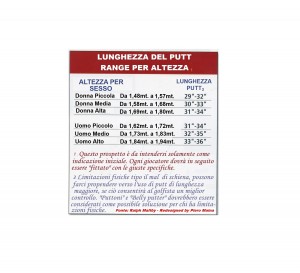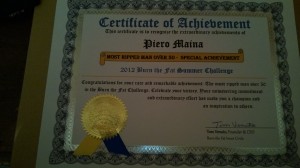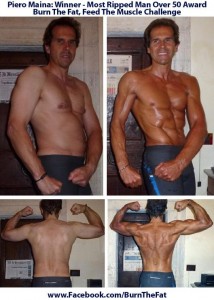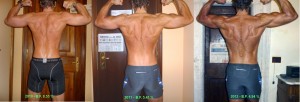Titolo: Odontoiatria: Come ho risolto la terza classe scheletrica o morso inverso con linea mediana across….la mia esperienza
Autore: Piero Maina
Conteggio Parole: 4163
Cari lettori, avevo scritto più di un anno fa un articolo sulla mia esperienza (qui) con il libro che promuovo su questo sito: “Burn The Fat Feed The Muscle” e i benefici che ne avevo/ho ricavato a livello di forma fisica e buona salute. Apro una parentesi ( Diciamo che l’argomento non trova una precisa collocazione all’interno di questo blog perché parla di denti, ma la sua correlazione è tutt’altro che trascurabile come collegamento trasversale alle categorie a cui lo ho assegnato e l’ho quindi inserito all’interno del menù “tenersi in forma”). In quel contesto avevo raccontato tutte le mie problematiche a livello di salute e incidenti vari che avevano accompagnato la mia esistenza e avevo scritto che a breve avrei raccontato come avevo risolto il problema dei denti che sia come fatto estetico, ma ancora di più funzionale, aveva condizionato la mia vita fino all’anno 2010, anno in cui ho risolto con la sola cura ortodontica un caso che era sempre stato definito risolvibile solo chirurgicamente e considerato grave ed inoltre è stato risolto in una età compresa fra i 46 anni e sei mesi e 48 anni e 4 mesi. Quindi in età più che adulta. Premetto che non sono un dottore, ma di “dottori” ne ho incontrati molti e a molti ho chiesto pareri professionali. La tristezza nasce quando siamo pazienti “ignoranti” e ci rivolgiamo appunto ad un professionista, con la speranza che il suo “sapere” risolva la nostra situazione nel migliore dei modi. Come in ogni ambito professionale, ci sono professionisti e professionisti, ma noi siamo sempre gli “ignoranti” e quando per correttezza vogliamo ascoltare più di un parere, diventa difficile quando il parere di A e quello di B sono diametralmente opposti. Se poi come spesso accade volessimo ascoltare anche il parere di C e disgraziatamente anche questo parere risultasse essere completamente discordante con quello dei due professionisti precedentemente interpellati, allora diventa veramente difficile fare una scelta corretta. Questo avviene anche nella mia professione con i bastoni da golf, ma qui stiamo parlando di salute e non di oggetti inerti e aggiungo anche, quando le consulenze non sono fatte in buona fede.
Per raccontare la mia storia/esperienza, bisogna partire dai tempi della gioventù, quando le prime carie e le prime trapanazioni, magari effettuate da dottori non proprio professionalmente ineccepibili, mi fecero compagnia. Stiamo parlando dei primi anni 70, quando le stesse tecniche non erano sicuramente paragonabili a quelle odierne. Resta il fatto che rimasi traumatizzato durante un’estrazione. Avevo quasi tredici anni, era il 1973 ed ebbi la sfortuna di avere un molare (il 16 per chi è del mestiere), cariato e non curabile con le radici convergenti fino a toccarsi. Il dentista in questione impiegò quasi un’ora ad effettuare l’estrazione e il dolore che provai, nonostante l’anestesia, non posso raccontarlo, oltre alla febbre molto alta che mi accompagnò nei giorni seguenti, etc. Risultato: non volli vedere mai più un dentista.
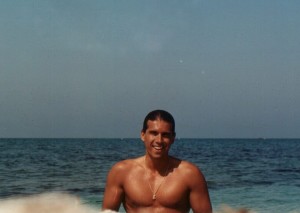
Clicca sull’immagine per ingrandire
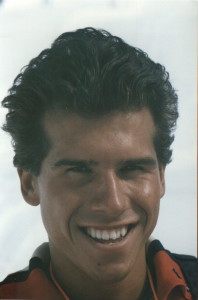
Clicca sull’immagine per ingrandire
Naturalmente, non curando i miei denti, mangiando molti dolciumi e altro, le carie ai vari molari, non tardarono a venire e quando il dolore divenne insopportabile, ricorsi mio malgrado alle cure di altri dentisti che nuovamente non all’altezza curarono i miei denti in maniera non proprio impeccabile. Della terza classe scheletrica o morso inverso, non me ne ero mai accorto né nessuno me lo aveva mai fatto notare e a detta di molti ero anche un “bel ragazzo” e spesso veniva lodato il mio sorriso. Poi un giorno nel 1989 una signora (dentista), parlando con me del più e del meno mi dice :”…tu hai il morso inverso…” da quel momento la mia attenzione cadeva sempre sulla mia bocca o su quella degli altri per notare la differenza e nacque in me un vero e proprio complesso. Arriviamo al 1993; non farò né nomi di persona né di luoghi a questo punto, ma incontrai un dentista nella sede lavorativa dove mi ero trasferito in quell’anno e questo dentista mi restituì la fiducia verso la categoria e curò la mia bocca facendola diventare una bella bocca. Rimasi in quella città fino al 1995 e naturalmente gli chiesi se la mia situazione di “morso inverso” si potesse risolvere. Fatte le dovute analisi e con le competenze che lui e i suoi colleghi avevano a quei tempi, mi disse che non si poteva fare nulla, sconsigliava la chirurgia e avrebbero voluto togliermi altri denti per diminuire l’affollamento nei denti inferiori e con la cura ortodontica “ridistribuire” i restanti, ma la discrepanza mandibolare era troppa e quindi mi disse di lasciare perdere. In fondo la mia mandibola non si bloccava e anche per lui avevo un bellissimo sorriso e quindi mi disse che era meglio non procedere.
Accettai la cosa, ma in cuor mio non smisi mai di sperare per una soluzione del mio caso ed arriviamo al 2007. Prima di proseguire, voglio spiegarvi che nonostante fossi rientrato a Roma, pur di non cambiare dentista, ogni 6 mesi facevo più di 1.200 km fra andata e ritorno per andare dal vecchio dentista per cercare di mantenere una bocca sana e in parte ne approfittavo per andare a trovare i miei genitori che erano di strada. Un’altra cosa va detta, nonostante la mia bocca sembrasse essere sana, ogni qualvolta affrontavo la profilassi di igiene dentale, le mie gengive sanguinavano e il dolore era forte, ma anche in questo caso non mi venne detto niente e si diceva che per colpa della situazione di “affollamento” e dei denti storti era una condizione paradontale con cui convivere e di cercare di mantenere la situazione della riduzione delle gengive sotto controllo il più possibile. Torniamo a noi: a marzo 2007 prendo un volo per Atlanta (USA) e su un Boeing con più di 360 passeggeri a bordo, mi ritrovo seduto nel posto a fianco un caro e vecchio amico di gioventù che non rivedevo dal 1985. Destino? Sincronicità? Non lo so, resta il fatto che non ci eravamo dati appuntamento e io partivo da Roma per un convegno sui bastoni da golf negli USA e lui era diretto in Texas, proveniente da Genova per un convegno sull’implantologia dentale.
Quando ci siamo rivisti, passato il primo momento di stupore e gli abbracci di due vecchi amici che non si vedevano da ventidue anni, abbiamo naturalmente cominciato a parlare, ricordandomi di lui come un windsurfista con cui facevo le regate insieme. Non potevo immaginare che nel frattempo era diventato uno dei più affermati implantologi Italiani. Gli chiesi allora cosa ne pensava della mia situazione dentale e lui senza entrare troppo nel tecnico mi disse che a quel momento c’erano nuove tecniche ortodontiche e che le cose potevano essere risolte, ma non mi disse nulla di specifico a riguardo. Così, arrivati ad Atlanta ci congedammo e ci scambiammo i numeri di telefono, ma non prendemmo nessun appuntamento o altro. Per come sono fatto io, se decido che una cosa m’interessa, vado subito fino in fondo e voglio capirne di più, ma ammetto che non essendo entrato troppo nel merito della mia situazione e ricordando il mio amico come un windsurfista, non colsi l’occasione di andare a trovarlo (anche lui di Genova e quindi abitava vicino a dove abitavano i miei genitori) e lasciai passare un altro anno.
Aprile 2008: tornai dal mio dentista a 600 km di distanza a Savona che non vedevo da un anno e durante la solita profilassi di igiene e controllo dentale, gli chiesi cosa ne pensasse della mia situazione di “morso inverso” dopo 13 anni dalla prima diagnosi, e lui mi rispose che ora aveva le competenze per risolvere il mio caso e che ne aveva già risolti altri quattro. Mi spiegò che avrebbe lavorato in equipe con una ortodontista di Genova e un medico chirurgo specializzato nel maxillo facciale molto bravo e che il mio caso era di facile soluzione. Avrei dovuto portare un apparecchio ortodontico per circa due anni per raddrizzare nuovamente i denti e una volta in asse procedere con l’operazione di riduzione mandibolare per ristabilire il “morso” corretto e risolvere il problema di malocclusione dentale. Sempre a suo dire non avrei sofferto troppo e per il chirurgo era una delle operazioni più semplici da eseguire e io naturalmente avevo massima fiducia in lui. A quel punto gli chiesi se conoscesse il mio amico implantologo, ma mi rispose di no e gli chiesi se conoscesse la tecnica Damon, ma anche in quel caso la risposta fu negativa, mi disse che per me c’era la sola via chirurgica per risolvere e se volevo, potevo incontrare l’ortodontista che collaborava con lui a Genova per sentire cosa ne pensasse della mia situazione. Visto che era di strada andai immediatamente a fare un primo controllo sommario, una visita a vista e anche la dottoressa ortodontista, mi disse che ero un caso chirurgico grave. Chiesi a lei se conoscesse il mio amico implantologo e mi disse di si, chiesi se conoscesse la tecnica Damon e mi rispose affermativamente, ma mi disse anche che per me il “Damon” non serviva a nulla e potevo risolvere la mia situazione di “terza classe” chirurgicamente e definitivamente, previa l’applicazione di un apparecchio ortodontico per circa due anni.
Ammetto che volevo risolvere la questione e la mia fiducia era massima ed ero quindi disposto oltre ai costi, a sopportare l’inserimento di un apparecchio ortodontico nella mia bocca, a viaggiare da Roma fino in Liguria mensilmente per il controllo dello stesso e a subire un’operazione alla mandibola in seguito che a differenza di come veniva venduta dal mio dentista, non era poi una vera e propria “passeggiata di salute”.
Voglio anche dire che la mia situazione di malocclusione dentale, contribuiva a farmi deglutire in maniera errata, il fatto era dovuto alla mia lingua che invece di appoggiare correttamente contro il palato durante le normali attività quotidiane, o sotto sforzo o ancora durante la deglutizione, appoggiava contro l’arcata dei denti inferiori, contribuendo ulteriormente a spingerli verso l’esterno.
Rientrato a Roma provai a sentire un parere di un noto ortodontista della Capitale, il quale fece tutte le misurazioni del caso e non si sbilanciò, disse che in effetti era una “terza classe scheletrica across/ cross byte” (oltre ad avere il morso inverso, avevo la linea mediana disassata di un dente verso sinistra, questo per il fatto che l’estrazione del molare “16” quando avevo tredici anni, creò uno spazio in bocca e i denti che sono mobili, sono migrati verso destra andando a chiudere quello spazio, creando una nuova problematica). L’Ortodontista romano, disse che probabilmente avrebbe dovuto risolvere la cosa chirurgicamente, ma si prese tempo per decidere. Nel frattempo mi disse che prima di risolvere il problema della terza classe across, c’era da sistemare la mia bocca, sia a livello paradontale che di altre “situazioni non a norma” presenti nella mia bocca e mi chiese se il mio attuale dentista non me ne avesse mai parlato. Io risposi che sanguinavo e sentivo male quando effettuavo la pulizia dei denti, ma nient’altro. Il professionista romano, mi chiese se poteva comunicare con il “collega” Ligure e io naturalmente risposi di si.
Al telefono i due discussero animatamente e naturalmente il mio dentista si sentì offeso perché interpellato da un altro medico. Io dissi che pur comprendendo l’accaduto, mi sentivo in dovere di andare a parlare con il mio dentista a Savona, anche perché mi curava da 15 anni e io avevo fiducia in lui. Quando andai dal mio dentista, e parliamo di maggio 2008, mi ricevette dicendomi che quello di Roma non doveva permettersi di chiamarlo e che se volevo risolvere la mia situazione, non c’erano alternative o altro. Era inutile girarci intorno e trovare mezze misure, dovevo agire nel migliore dei modi e in maniera definitiva. Mi convinse, ero pronto ad iniziare l’avventura di portare l’apparecchio e poi dopo due anni affrontare l’operazione e ritrovare un bel sorriso e una postura più corretta. Ultimamente infatti, quando effettuavo certi tipi di lavoro in piedi per lungo tempo, le fitte alla base del collo erano diventate sempre più insopportabili, quasi come un cane che lo mordesse e questa patologia era sicuramente dovuta alla mia mala occlusione dentale.
Esco dallo studio del mio dentista a Savona, e qui il destino/sincronicità ritornano in gioco: stavo tornando verso l’autostrada per rientrare e alcuni giorni prima, un maestro di golf di Roma mi aveva detto che suo fratello stava lavorando in un nuovo circolo di golf ad Albisola (SV) e sapendo che dovevo andare da quelle parti, magari potevo andare a salutarlo. Premetto che ero amico del maestro di golf, ma il fratello l’avevo visto solo un paio di volte e quindi, sinceramente, non è che avessi urgenza di passare a salutarlo. Stavo quindi pensando di prendere l’autostrada per rientrare, anche perché non sapevo bene dove si trovasse il circolo in questione, ma di nuovo le circostanze di traffico mi fecero andare a prendere l’autostrada ad Albisola invece che a Savona e arrivando nei pressi del casello, vidi uno di quei cartelli segnaletici turistici marroni con su scritto “La Filanda Golf Club”. “Toh!” Mi dissi, “…è qui vicino, ci faccio un salto”. Il fratello del mio amico maestro, maestro anche lui, all’inizio non si ricordava nemmeno di me, ma portandogli i saluti del fratello e poi ricordandogli il mio nome ritrovò la memoria e mi disse:”…sta venendo da alcuni giorni una mia allieva da Genova a giocare e mi ha parlato di te, perché un suo amico che non gioca a golf le ha raccontato della tua bravura come clubmaker/clubfitter….. non ricordo come si chiama, ma aspetta che la chiamo e mi faccio dire….”. Naturalmente sembra impossibile, ma l’amico in questione era il mio amico implantologo! A questo punto, visto il modo nuovamente casuale e insolito in cui il mio amico Alberto era tornato “in gioco”, decisi di chiamarlo per raccontargli le novità . Al telefono gli raccontai pima dove mi trovavo e poi come per la seconda volta era tornato presente nella mia vita ed aggiunsi che ero a Savona perché avevo deciso di risolvere chirurgicamente la mia questione dentale…”FERMO!!!! FERMO!!!!” Urlò al telefono. Mi chiese se rimanevo ancora in zona e risposi che sarei ripartito nel pomeriggio seguente e allora m’invitò a passare nel suo studio di Genova la mattina seguente che voleva darmi un’occhiata.
Anche la sua visita sommaria, lo fece propendere come una terza classe risolvibile chirurgicamente, ma guardandomi attentamente, secondo lui c’erano le condizioni per un recupero e che c’era una dottoressa a Milano che forse avrebbe potuto risolvere la mia situazione non chirurgicamente e con risultati analoghi e questo mi venne detto da “fratello a fratello”. Voglio inoltre aggiungere che tutta la famiglia del mio amico lavora in ambito dentistico, essendo figli d’arte e uno dei tre fratelli è anche un bravissimo ortodontista che probabilmente avrebbe potuto lavorare al mio caso, ma la professionalità del mio amico Alberto fu massima e mi invitò ad andare a Milano con lui previa effettuazione del Telecranio e ortopanoramica. Presi appuntamento per il 10 giugno 2008.
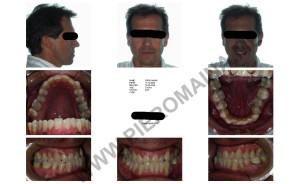
Clicca sull’immagine per ingrandire
La dottoressa/ortodontista Milanese, quando mi vide, disse purtroppo anche lei che ero un caso chirurgico grave e nonostante a me non sembrasse di essere in una condizione così grave, la cosa veniva ripetuta da tutti e visti anche molti casi con situazioni anche diverse dalla mia risolti dalla dottoressa, nella mia percezione il mio caso sembrava davvero più facile. Comunque la dottoressa pur manifestando perplessità, disse che avrebbe voluto provarci d’accordo con il mio amico Alberto e io dissi che ero pronto e fiducioso a cominciare l’avventura. Mi venne detto che sarebbe stato utilizzato un apparecchio Damon e degli elastici e la percentuale di successo era proporzionale anche al mio impegno e al mantenimento in bocca degli elastici 24/24. Naturalmente tolti i tempi per mangiare cibi solidi. Risposi che se alla mia età non avessi dato il massimo allora non sarei stato nemmeno la persona che sapevo di essere. Il 12 Giugno 2008 a Milano avevo il mio apparecchio Damon con gli elastici in bocca ed ero pronto anche ad affrontare l’avventura con tutti gli annessi e connessi.
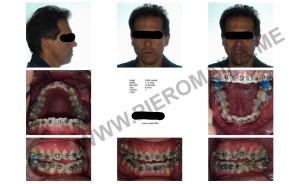
Clicca sull’immagine per ingrandire
Che dire, l’avventura era iniziata e anche il “sacrificio” sia estetico che funzionale. Infatti l’apparecchio faceva il suo lavoro e le forze che agivano sui miei denti non erano proprio inesistenti. Era come sentire delle “morse” che spingevano sulle radici, oltre agli elastici che nel loro piccolo contribuivano a “spingere” e che toglievo quando dovevo mangiare, ma appena terminato, via a lavarmi i denti con spazzolino ortodontico e scovolino (curaprox cp15 per l’esattezza) e subito dopo li rimettevo al loro posto. Naturalmente la situazione del fastidio/dolore si stabilizzava dopo una settimana/dieci giorni, l’unico problema è che io abitavo a Roma e la dottoressa a Milano e pertanto in caso di urgenza non era proprio il massimo. Infatti è capitato che il “filo” di acciaio del Damon ogni tanto sporgesse in fondo e mi bucasse la guancia o gli attacchi mi ulcerassero l’ interno delle labbra. Risolvevo la cosa mettendo della cera sugli attacchi e addirittura delle volte ho agito con le pinze da elettricista per tagliare la sporgenza del cavetto. Non vi spaventate, sono cose che capitavano sporadicamente, ma sono capitate. Come una volta mentre ero all’estero si ruppe l’archetto superiore e dovetti trovare un ortodontista che lavorava con il Damon, ma lo trovai e risolsi anche questo incidente. Qualche fastidio l’ho provato, ma niente di trascendentale o altro che non potesse essere risolto . Voglio ricordare che comunque anche in caso di operazione avrei dovuto portare l’apparecchio ortodontico per circa due anni ugualmente e solo al termine avrei subito l’operazione alla mandibola che ricordo non essere proprio il massimo da affrontare e sempre senza la certezza di riuscita, oltre alle sofferenze che intercorrono.
Mi viene attribuito parte del successo per la mia collaborazione ad indossare gli elastici 24/24, oltre che ad aver effettuato la pulizia dei denti ad ogni pasto. Come ho già scritto sopra, sarebbe stato veramente inutile se una volta apprese le regole comportamentali io avessi agito a modo mio. Ho eseguito solamente quanto mi è stato detto e il risultato è sotto gli occhi di tutti. Gli elastici e le molle che vengono inseriti in bocca sull’apparecchio opportunamente posizionati e calibrati, applicano delle forze costanti e in specifiche direzioni, che daranno i risultati che anche io ho ottenuto, ma a patto che queste forze non vengano mai interrotte. Qui sta parte della difficoltà nell’eseguire il lavoro con competenza e professionalità per avere buone probabilità di successo. Se le forze non vengono applicate nella direzione giusta e con la giusta intensità, si otterranno nuovi problemi e per usare un paragone sul Damon, è come dare una Ferrari a un diciottenne neopatentato….molto probabilmente si schianterà contro un albero!
Già da Settembre 2008 dopo soli tre mesi si erano visti enormi cambiamenti.
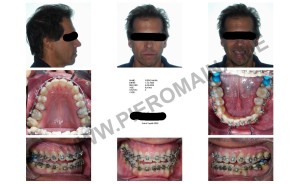
Clicca sull’immagine per ingrandire
Oltretutto sono al corrente che i nuovi apparecchi Damon sono anche meno visibili e
tecnologicamente più avanzati di quelli che ho messo io. Nelle foto qui sopra vedete degli spessori blu sugli ottavi, (sono gli ultimi denti) dei “tacchi”. Sono spessori che vengono messi, per far si che l’apparecchio e gli elastici possano lavorare. Che vuol dire che la mandibola rimane dov’è ora e sarà l’arcata superiore che comincerà a migrare verso l’avanti, senza essere inibita dall’arcata inferiore e fino a diventare “testa a testa”, per me nel mese di Novembre 2008.
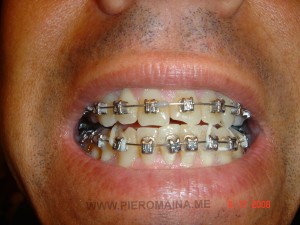
Clicca sull’immagine per ingrandire
Ho “scavallato” con l’arcata superiore nella prima settimana di Gennaio 2009
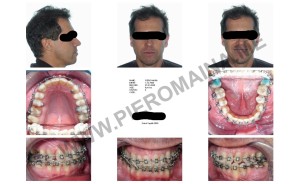
Clicca sull’immagine per ingrandire
e poi è stato un divenire di miglioramenti ogni mese che passava e a differenza di quanto altri ortodontisti avrebbero fatto, mi è stato ripristinato lo spazio nel settore 1 (superiore destro), per permettere di fare l’impianto del 16 (sesto) molare che era il dente estratto all’età di tredici anni ed era stato il responsabile della mia situazione “crossbite /Morso crociato“. Qui potete vedere il dettaglio dalle foto, dove è stata inserita una molla che “spinge” i denti fino a ricreare lo spazio originale. Qui siamo a settembre 2009.
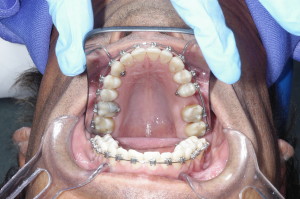
Clicca sull’immagine per ingrandire
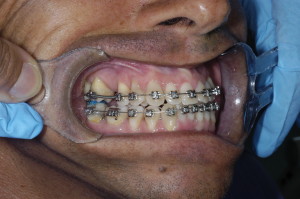
Clicca sull’immagine per ingrandire
Arriviamo finalmente ad Aprile 2010 quando ho levato il Damon dalla mia bocca.
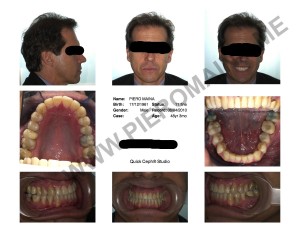
Clicca sull’immagine per ingrandire
Naturalmente porto un “filetto” fisso all’interno dei denti inferiori che non si vede e che mantiene stabile l’arcata inferiore evitando recidive (splint è il nome in gergo) e la notte indosso un apparecchio mobile di contenzione per mantenere a sua volta stabile e consolidare la situazione dell’arcata superiore. Inoltre nei due anni successivi ho sistemato altre imperfezioni nella mia bocca che andavano fatte, compreso un primo innesto di gengiva nella parte inferiore sinistra con ottimi risultati.
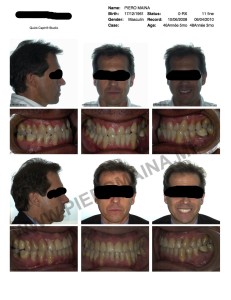
Clicca sull’immagine per ingrandire
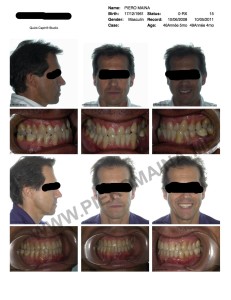
Clicca sull’immagine per ingrandire
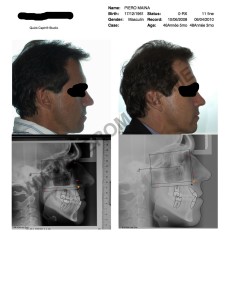
Clicca sull’immagine per ingrandire

Dopo esecuzione igiene orale
Clicca sull’immagine per ingrandire
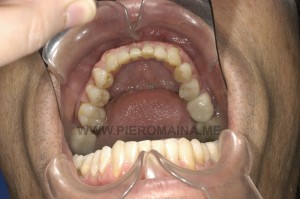
Dopo esecuzione igiene orale
Clicca sull’immagine per ingrandire
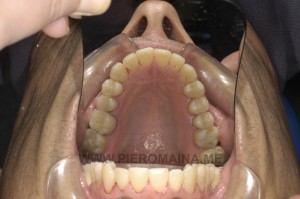
Dopo esecuzione igiene orale
Clicca sull’immagine per ingrandire
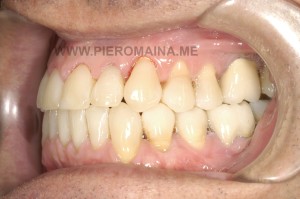
Dopo esecuzione igiene orale
Clicca sull’immagine per ingrandire
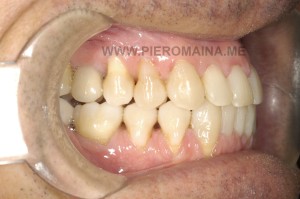
Dopo esecuzione igiene orale
Clicca sull’immagine per ingrandire

Clicca sull’immagine per ingrandire
Nota: Il sangue che vedete sulle gengive nelle foto qui sopra è dovuto al fatto che pochi minuti prima dello scatto mi era stata fatta la profilassi di igiene orale con gli ultrasuoni e pertanto le gengive erano in stato di stress. Ovviamente dopo poco tempo tutto torna alla normalità. Inoltre si nota che la linea mediana non è perfettamente allineata, ma oltre ad essere veramente una differenza minima, il fatto è anche amplificato dalle leve posizionate all’interno delle labbra per “allargare” la vista sui denti e vi posso assicurare che ad oggi questa differenza si è ulteriormente ridotta e mi vedo perfettamente allineato.
Il movimento dell’arcata superiore verso l’avanti è avvenuto utilizzando solamente la tecnica ortodontica e senza l’utilizzo di alcuna chirurgia. Il metodo utilizzato permette, come è stato pubblicato sulla rivista scientifica Quintessence International (edizione italiana), di ottenere spostamenti ossei ortopedici uguali in misura lineare a quelli ottenuti con la tecnica chirurgica e misurabili sulle radiografie durante e dopo la cura. Ma la tristezza è che in ambiente medico ci sono medici chirurghi che hanno il coraggio di dire che non è vero che abbiamo risolto come ho raccontato e con la sola cura ortodontica, ci sono personaggi che pur di ingrossare il loro portafoglio, non avrebbero alcun timore a mettere mano ai ferri e operare; hanno persino accusato la mia dottoressa che sia il telecranio che le foto finali sono truccate!!!
Ancora una volta il pensiero positivo ha permesso che le cose si risolvessero nel migliore dei modi. Il risultato lo avete visto nelle foto che ho pubblicato. E’ stato raggiunto un ottimo compromesso di compensazione che forse non sarebbe stato raggiunto nemmeno con la via chirurgica, senza contare le sofferenze a cui sarei andato incontro. L’aspetto estetico è quello di una bocca sana ora e anche a livello paradontale la situazione è tutta un’altra cosa. Lo vedo anche durante le sessioni di profilassi e igiene dentale e dal colore delle mie gengive. Funzionalmente anche la mia schiena ne ha beneficiato e ora, pur avendo le vene succlavia ed ascellare sinistre interessate dalla trombosi danneggiate per sempre, sono tornato ad allenarmi regolarmente ed eseguo anche trazioni alla sbarra e spinte verso l’alto con i manubri per le spalle. Ricordo per chi non avesse letto l’articolo a cui ho messo il link all’inizio di questa pagina, che non avevo più potuto allenarmi con i pesi per diciotto anni e la causa della trombosi era stata la conformazione scheletrica nella zona sterno clavicolare data anche dalla situazione dei miei denti e mala occlusione. Diciamo che è stato come essere trattenuto da delle bretelle e finalmente questo vincolo è stato rimosso e ho riacquistato la mia funzionalità e la voglia di sorridere in tutti i sensi.
Concludo dicendo che questa è la mia esperienza e quanto ho raccontato corrisponde al vero e chi mi conosce di persona lo sa. Naturalmente ogni caso va visto a se ed inoltre un ruolo fondamentale lo svolge il paziente per il grado di impegno, applicazione e collaborazione. Va detto che ho inviato alla Dr.ssa un amico Milanese di 41 anni che aveva una situazione analoga alla mia e anche lui ha risolto felicemente la sua situazione effettuando lo stesso tipo di “cura” e ora è un’altra persona. Spero che alcuni di voi leggendo queste mie righe trovino lo spunto per intervenire e possano risolvere una problematica che so quanto incide sulla qualità della vostra vita. In bocca al lupo!
© Copyright Piero Maina – Tutti i diritti riservati












